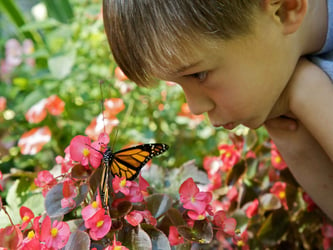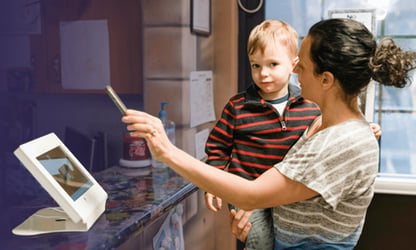Spring is a magical time of year, especially for preschoolers who are eager to explore and learn. Great spring preschool activities for kids play a big part in developing cognitive skills and encouraging social interaction. Let's dive into fun, educational spring activities and learn how you can incorporate these activities into the curriculum, touching on subjects like science, math and language arts. And since it's spring, your classroom will benefit as you embrace the beauty of the season with these engaging and enriching activities for young learners.
Table of Contents
- What Are Spring Preschool Activities?
- Why Are Spring Preschool Activities Important?
- What Are Some Fun Spring Preschool Activities?
- How Can Spring Preschool Activities Be Incorporated into the Curriculum?
- What Are Some Additional Resources for Spring Preschool Activities?
- FAQs
What Are Spring Preschool Activities?

Spring preschool activities are engaging educational experiences designed for young children to explore the wonders of the spring season. These activities incorporate a mix of interactive play, creative projects and nature-based exploration to enhance learning and development.
From planting seeds and learning about plant life cycles to observing the changes in the environment, spring-themed activities for preschoolers provide a hands-on approach that stimulates curiosity and fosters a deeper understanding of the natural world. Craft activities like making flower crowns or painting with spring colors not only encourage creativity but also help in improving fine motor skills and hand-eye coordination.
Why Are Spring Preschool Activities Important?

Engaging preschoolers in spring activities is crucial as it promotes physical, cognitive and social development while fostering a love for learning and exploration. These activities contribute to the holistic growth of young children, providing them with valuable experiences and skill-building opportunities.
- Develop motor skills: From digging in the dirt to planting seeds, spring activities help preschoolers refine both fine and gross motor skills. (National Library of Medicine)
- Boost cognitive development: Sensory exploration through flower picking, bug hunts and nature walks stimulates curiosity and learning. (National Institutes of Health)
- Build social skills: Planting seeds together or creating spring crafts fosters teamwork, sharing, communication and collaboration. (University of Nebraska)
- Love of learning and exploration: Spring activities encourage a love for exploration and discovery in the natural world. (Education Resources Information Center)
- Holistic development: Spring play contributes to a well-rounded development for preschoolers — physically, mentally and socially. (Harvard)
Promotes Physical Development
Spring offers a wealth of sensory experiences that stimulate preschoolers' cognitive development. From feeling the textures of nature to smelling fragrant flowers, these activities engage their senses and help them learn about the world around them. Here are some spring activities for preschool that are great for fine motor and physical development.
- Outdoor play during spring is a natural gym. Running, jumping, climbing and exploring the outdoors contribute to their physical fitness and overall health.
- Spring is a time for hands-on exploration. Whether it's planting seeds, building with sticks, or playing with balls, these activities help enhance gross and fine motor skills, coordination and spatial awareness.
- Movement-based activities like dancing or playing with balls are a blast and improve their balance, strength and stamina.
- All of these experiences during springtime are crucial for building a strong foundation for lifelong physical well-being.
Enhances Cognitive Skills
Participating in preschool spring activities enhances cognitive skills in preschoolers by integrating science experiments, math games and concepts and literacy-focused tasks. These activities stimulate curiosity, critical thinking and language development in young learners.
During science experiments, children explore cause-and-effect relationships, develop observation skills and learn to make predictions based on evidence. Math concepts such as counting flowers or measuring plant growth not only enhance numerical skills but also foster problem-solving abilities. Literacy-focused tasks like story time sessions or nature journals help improve vocabulary, comprehension and storytelling skills.
Engaging in such multifaceted activities not only cultivates academic knowledge but also nurtures creativity, collaboration and a love for learning. By incorporating various educational elements into spring activities, preschoolers develop a well-rounded set of cognitive skills that lay a strong foundation for their future academic success.
Encourages Social Interaction
Spring activities encourage social interaction among preschoolers by fostering collaborative projects, nature exploration and artistic endeavors. These activities promote communication, teamwork in the classroom, and sharing among young children.
Engaging collaborative projects during spring lesson plans allows children to learn how to work together, solve problems and share ideas. When preschoolers explore nature, they develop a deeper appreciation for the environment, learn about plants and animals and understand the importance of taking care of the world around them. Involving children in artistic endeavors like painting, crafting and drawing nurtures their creativity, expression and imagination.
What Are Some Fun Spring Preschool Activities?

Fun and favorite spring preschool activities such as scavenger hunts and flower-themed relay races not only promote physical activity but also foster an appreciation for the environment. This list of spring activities includes elements of nature, sensory play and outdoor fun to create memorable learning experiences for young children.
- Sensory garden: Create a garden where kids can touch, smell and see a variety of flowers. Add sensory bins filled with soil, petals and seeds — it's the perfect hands-on way for kids to explore nature's beauty and stimulate their senses.
- Flower picking and bouquet making: Let kids pick fresh flowers and create beautiful and colorful bouquets. This is a wonderful way to engage them in the wonders of spring and identify all the colors of the rainbow.
- Outdoor games: After spending more time indoors during the winter months, students will relish the chance to get outside and play games like hide-and-go-seek, foot races, playing with balls and more.
Here are a few options for preschool spring outdoor activities.
Planting Seeds
Planting seeds is a hands-on springtime activity that introduces preschoolers to the concept of growth, nature and responsibility. This fun activity helps children learn about plants, seeds and the importance of caring for living things.
By involving children in the process of planting seeds, they develop a sense of ownership and connection to the natural world around them. As they carefully place the seeds into the soil and provide water and sunlight, they witness firsthand the magic of germination and growth. Through this experience, preschoolers also gain valuable lessons in patience and nurturing. They observe how plants change over time, from tiny seedlings to flourishing flowers or vegetables.
To keep track of which seeds you've planted and how they're progressing, a seed planting chart like this free downloadable option is a great choice.
Nature Walk and Scavenger Hunt
A nature walk and scavenger hunt are exciting spring activities for preschoolers to explore the outdoors, observe insects, butterflies and plants and engage in a hands-on learning adventure. These activities promote curiosity, observation skills and appreciation for the natural world.
During these explorations, children can discover the beauty of nature up close, learning about different types of leaves, flowers and trees. Hands-on experiences like examining tiny insects or spotting colorful butterflies can fuel their curiosity and encourage a sense of wonder. These activities provide an opportunity for children to develop their observation skills as they search for hidden treasures with each step they take. The sensory-rich environment of the great outdoors enhances their understanding of the world around them, making learning a captivating and interactive experience.
Spring-Themed Arts and Crafts
Engaging in spring-themed arts and crafts allows preschoolers to express their creativity, explore different colors and create seasonal masterpieces. These activities foster artistic skills, fine motor development and imaginative thinking in young learners.
As they create art and crafts, preschoolers engage in hands-on projects that enhance their sensory experiences and cognitive abilities. Experimenting with different textures, materials and techniques helps children learn through play while developing their problem-solving skills. Whether they are painting vibrant fake flowers, creating paper butterfly crafts, or making nature-inspired collages, these activities nurture self-expression and build confidence. The process of creating spring art encourages children to communicate their emotions and thoughts in a visual way, fostering their language development and enhancing their overall well-being.
Egg and Spoon Race
The egg and spoon race is a classic spring game for preschoolers that promotes balance, coordination and friendly competition. This seasonal activity encourages teamwork, physical movement and excitement among young children.
Children eagerly take on the challenge of balancing an egg on a spoon while navigating a course, giggling with delight as they try to keep their fragile cargo from falling. The race fosters a sense of accomplishment as kids cheer each other on, developing their social skills and sportsmanship. With each step, preschoolers hone their motor skills, concentration and agility, leading to improved hand-eye coordination and confidence. The joy and thrill of the egg and spoon race create unforgettable memories that spark a love for active play and outdoor fun.
Butterfly Life Cycle Activity
Exploring the butterfly life cycle is a perfect addition to your spring activities that introduces preschoolers to science, nature and the wonders of metamorphosis. This hands-on activity allows children to observe, learn and appreciate the beauty of butterflies.
Engaging in this educational journey, preschoolers witness the magical transformation from egg to caterpillar, then chrysalis, culminating in the emergence of a stunning butterfly. Children witness life cycle stages vividly through firsthand observation, sparking curiosity and fostering a deep appreciation for the natural world. By immersing themselves in this experience, children develop a deeper understanding of the intricate processes that govern life forms around them, fostering a sense of connection with nature and scientific exploration. Unlocking the mysteries of metamorphosis through hands-on exploration cultivates a sense of wonder and awe in young minds.
You can also use a free printable resource to track the life cycle of a butterfly and use it to help students better grasp the different stages the butterflies in your classroom go through.
How Can Spring Preschool Activities Be Incorporated into the Curriculum?

Spring brings a wealth of opportunities to create a fun and engaging learning environment! Looking for preschool spring learning ideas? Here's how you can seamlessly integrate spring preschool themes into your curriculum:
- Science: Explore the wonders of spring with lessons on seasons and plant life. Watch seeds sprout, observe baby animals and discuss the changing weather. Celebrate Earth Day!
- Math: Make counting fun with spring objects! Count flowers, ladybugs, or raindrops to reinforce numeracy skills in a playful way.
- Language Arts: Spark a love for reading with story time with a spring theme. Spring poems, songs and stories can improve vocabulary and comprehension.
- Writing: Encourage creativity by having children write about their springtime experiences. This can be anything from describing a spring flower to their favorite outdoor activity during spring.
These activities offer a multitude of benefits:
- Holistic learning: By combining subjects with a spring twist, you create a well-rounded educational experience that caters to various aspects of child development.
- Engagement: Fun spring activities and themes keep children interested and motivated to learn.
- Cognitive skills: Activities like counting and exploring nature nurture critical thinking and problem-solving skills.
- Social skills: Spring-based learning fosters interaction and collaboration as children work together on projects or share their observations.
Science: Learning About Seasons and Plant Life
Incorporating science activities into a specific spring curriculum allows preschoolers to learn about seasons, plant life and the natural world during the spring season. If you're looking for a fun way to make science accessible for preschoolers, these hands-on experiments and observations promote scientific exploration, curiosity and understanding of the environment.
By diving into science-based activities, young learners can develop a deeper appreciation for plant life, understanding how seeds sprout into vibrant flowers and trees. Exploring the seasonal changes during spring can spark their curiosity about the blooming process, helping them grasp the cycle of growth and renewal in nature. Through interactive experiments like planting seeds, observing plant growth and tracking weather patterns, children can enhance their observational skills while connecting theory with real-world phenomena.
Math: Counting Spring Objects
Spring math activities in a preschool curriculum focus on counting objects, such as flowers, insects, or raindrops, to enhance numerical skills, counting abilities and mathematical concepts. These hands-on and fun math tasks engage preschoolers in practical learning experiences.
Through interactive games using spring printables like Count the Flowers and Bug Bingo, children develop a solid foundation in numbers and quantities. Teachers incorporate creative number line activities to make counting fun and tangible. Using manipulatives like colored counters, kids build a strong numerical proficiency while exploring the season's themes. Small group activities, like counting ladybug spots, add an element of collaboration and peer learning to the math curriculum. These math exercises not only hone counting skills but also foster a deep understanding of mathematical concepts in young learners.
Language Arts: Spring-Themed Storytime and Writing Prompts
Language arts activities during spring include themed story time sessions and writing prompts that inspire creativity, language development and literacy skills in preschoolers. These engaging tasks encourage storytelling, vocabulary expansion and expressive writing.
Incorporating various literary elements such as characters, settings and plot development enhances the overall learning experience. By immersing young learners in imaginative worlds through storytelling, educators can cultivate a love for reading and writing. Through interactive writing activities like creating their own stories or poems, children not only enhance their language skills but also foster their creativity. This holistic approach to language arts education lays a strong foundation for effective communication and critical thinking skills.
What Are Some Additional Resources for Spring Preschool Activities?
Additional resources for spring preschool activities include the National Association for the Education of Young Children (NAEYC), preschool teacher blogs and websites and local parks and nature centers. These resources offer valuable ideas, lesson plans and support for educators and parents.
For those seeking a plethora of educational resources, the NAEYC is a go-to hub that provides insights into effective preschool teaching methods and developmentally appropriate activities for young learners. Exploring various preschool teacher blogs and websites can offer a diverse range of creative projects and engaging activities tailored to the unique needs of preschoolers.
Local parks and nature centers serve as fantastic venues for hands-on learning and spring sensory experiences, enabling children to explore the wonders of the natural world while partaking in fun outdoor activities that promote physical health and emotional well-being.
National Association for the Education of Young Children (NAEYC)
The National Association for the Education of Young Children (NAEYC) provides valuable resources and guidelines for implementing educational spring activities for young children. This organization offers insights, lesson plans and professional development opportunities for early childhood educators.
NAEYC plays a crucial role in setting standards for quality early childhood education and advocating for policies that benefit young learners. Through their research-backed resources, early childhood professionals can enhance their teaching methods and create engaging learning experiences. NAEYC's commitment to fostering a nurturing and supportive environment for children aligns with the best practices in the field of educational organizations.
Their contributions to promoting holistic development in children through play-based learning and interactive activities are highly regarded in the educational community. By emphasizing the importance of experiential education and hands-on approaches, NAEYC sets a benchmark for excellence in early childhood education.
Preschool Teacher Blogs and Websites
Preschool teacher blogs and websites offer a wealth of ideas, lesson plans and inspiration for implementing creative and engaging, easy and fun spring activities in the classroom. These online resources provide educators with innovative strategies, printable materials and community support.
By exploring teacher blogs and websites, preschool educators can access a plethora of fresh and interactive content tailored to young learners' needs. The diverse range of activities and resources found on these platforms caters to various teaching styles, ensuring that educators can customize their lesson plans effectively. The interactive nature of these online communities fosters collaboration and idea-sharing, allowing teachers to stay up-to-date on the latest trends in educational practices. This constant flow of inspiration plays a crucial role in enhancing classroom experiences and keeping both teachers and students engaged and motivated.
Local Parks and Nature Centers
Local parks and nature centers serve as ideal locations for conducting simple spring activities that involve outdoor play, nature exploration and environmental education. These natural settings offer immersive experiences, hands-on learning and sensory engagement for preschoolers.
In these outdoor spaces, children can develop a deep appreciation for the natural world while building essential skills. Imaginative, dramatic play amidst the lush greenery, flower gardens and diverse wildlife fosters creativity and curiosity in young minds. Exploring nature trails and observing plants and animals in their habitats sparks wonder and enhances environmental awareness.
The sensory-rich environment provided by local parks and nature centers stimulates children's senses, helping them connect with their surroundings on a profound level. The vibrant colors, varied textures and enchanting sounds of springtime create a multi-sensory experience that enhances learning and discovery and are perfect for a spring preschool curriculum.
Frequently Asked Questions
What are some fun hands-on spring preschool activities?
Some fun hands-on spring preschool activities include making flower crowns, planting seeds, creating butterfly life cycle crafts and going on nature scavenger hunts. These spring ideas engage children's intellectual curiosity while also inspiring thought through movement and activity.
How can I incorporate learning into spring preschool activities?
You can incorporate learning into spring preschool activities by teaching about the changing seasons, the life cycle of plants and animals and the importance of taking care of the environment. Encourage children to ask questions, explore and seek out more information on topics that interest them. Spring topics can be built into math and literacy lessons, dramatic plan and other games and activities students will love.
Are there any outdoor spring preschool activities that are educational?
Yes, there are many outdoor spring preschool activities that are educational such as counting and sorting nature objects, identifying different types of flowers and observing and drawing springtime animals. Many of these activities can be found in and around your preschool property, depending on location, or in nearby parks.
What are some sensory-based spring preschool activities?
Some sensory-based spring preschool activities include making spring-themed sensory bins, creating flower play dough shapes and painting with flower petals. Use these learning activities to teach children and give them a chance to grow their minds while being active.
How can I make spring preschool activities inclusive for children of all abilities?
When planning your preschool spring activities, you can make them inclusive by providing different options for participation, incorporating sensory activities and adapting the activities to suit different needs and abilities. Make sure to choose settings and activities that allow those with different physical skills and abilities to take part.
Can I use recycled materials for spring preschool activities?
Yes, you can use recycled materials for spring preschool activities such as creating bird feeders out of plastic bottles, making flower collages with recycled paper and using cardboard tubes to create springtime creatures. This is not only a chance to help a little one learn, but kids love a chance to help the planet as well. Many of these projects also make great Mother's Day gifts.
Get 70+ Editable and Printable Templates for Almost Every Preschool Situation

We know daycare providers like you are busy. That's why we made dozens of templates to help you manage the various aspects of your organization. From billing and invoicing to marketing materials, we have it all. Download all 70 today!
References:
-
Harvard University. "For Teenagers, Children, and Play: Studies Show Why It Matters." Harvard Health Blog, 21 May 2018.
-
Center for Applied Public Policy. "TAPP Research Brief: Early Childhood PDF". University of Nebraska-Lincoln, n.d.
-
National Institutes of Health. "NBK216774." National Institutes of Health, n.d.
- National Institutes of Health (NIH). "Cognitive Development In School-Age Children: Conclusions And New Directions - Development During Middle Childhood." https://www.ncbi.nlm.nih.gov/books/NBK216774/
- Penman, Joy and Ellis, Bronwyn. "Regional Academics' Perceptions of the Love of Learning and Its Importance for Their Students." ERIC, Department of Education, Feb. 2008, pp. 150-151.











